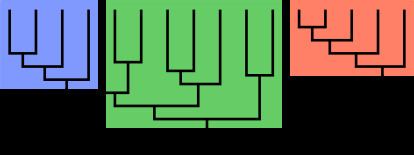 | ||
A2 clades
A clade (from Ancient Greek: κλάδος, klados, "branch") is a group of organisms that consists of a common ancestor and all its lineal descendants, and represents a single "branch" on the "tree of life".
Contents
- A2 clades
- Clade sheep official video
- Etymology
- History of nomenclature and taxonomy
- Definitions
- Clades and phylogenetic trees
- Terminology
- In popular culture
- References
The common ancestor may be an individual, a population, a species (extinct or extant), and so on right up to a kingdom. Clades are nested, one in another, as each branch in turn splits into smaller branches. These splits reflect evolutionary history as populations diverged and evolved independently. Clades are termed monophyletic (Greek: "one clan").
Over the last few decades, the cladistic approach has revolutionized biological classification and revealed surprising evolutionary relationships among organisms. Increasingly, taxonomists try to avoid naming taxa that are not clades; that is, taxa that are not monophyletic.
Clade sheep official video
Etymology
The term "clade" was coined in 1957 by the biologist Julian Huxley to refer to the result of cladogenesis, a concept Huxley borrowed from Bernhard Rensch.
Many commonly named groups are clades, for example, rodents or insects; because in each case, their name refers to a common ancestor with all its descendant branches. Rodents, for example, are a branch of mammals that split off after the end of the period when the clade Dinosauria stopped being the dominant terrestrial vertebrates 66 million years ago. The original population and all its descendants are a clade. The rodent clade corresponds to the order Rodentia, and insects to the class Insecta. These clades include smaller clades, such as chipmunk or ant, each of which consists of even smaller clades. The clade "rodent" is in turn included in the mammal, vertebrate and animal clades.
History of nomenclature and taxonomy
The idea of a clade did not exist in pre-Darwinian Linnaean taxonomy, which was based by necessity only on internal or external morphological similarities between organisms – although as it happens, many of the better known animal groups in Linnaeus' original Systema Naturae (notably among the vertebrate groups) do represent clades. The phenomenon of convergent evolution is, however, responsible for many cases where there are misleading similarities in the morphology of groups that evolved from different lineages.
With the publication of Darwin's theory of evolution in 1859, the idea was born that groups used in a system of classification should represent branches on the evolutionary tree of life. Thomas Henry Huxley, an early advocate of evolutionary theory, proposed a revised taxonomy based on clades. For example, he grouped birds with reptiles, based on fossil evidence. German biologist Emil Hans Willi Hennig (1913 – 1976) is considered to be the founder of cladistics. He proposed a classification system that represented repeated branchings of the family tree, as opposed to the previous systems, which put organisms on a "ladder", with supposedly more "advanced" organisms at the top. Taxonomists have increasingly worked to make the taxonomic system reflect evolution. When it comes to naming, however, this principle is not always compatible with the traditional rank-based nomenclature. In the latter, only taxa associated with a rank can be named, yet there are not enough ranks to name a long series of nested clades; also, taxon names cannot be defined in a way that guarantees them to refer to clades. For these and other reasons, phylogenetic nomenclature has been developed; it is still controversial.
Definitions
A clade is by definition monophyletic, meaning that it contains one ancestor (which can be an organism, a population, or a species) and all its descendants. The ancestor can be known or unknown; any and all members of a clade can be extant or extinct.
Clades and phylogenetic trees
The science that tries to reconstruct phylogenetic trees and thus discover clades is called phylogenetics or cladistics, the latter term coined by Ernst Mayr (1965), derived from "clade". The results of phylogenetic/cladistic analyses are tree-shaped diagrams called cladograms; they, and all their branches, are phylogenetic hypotheses.
Three methods of defining clades are featured in phylogenetic nomenclature: node-, stem-, and apomorphy-based (see here for detailed definitions).
Terminology
The relationship between clades can be described in several ways:
In popular culture
Clade is the title of a novel by James Bradley, who chose it both because of its biological meaning but also because of the larger implications of the word.
An episode of Elementary was titled “Dead Clade Walking” and dealt with a case involving a rare fossil.
